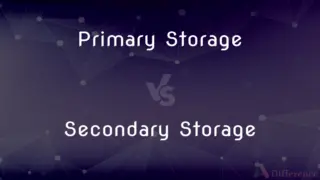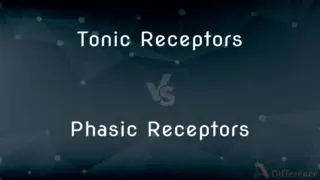Chlorine Atom vs. Chloride Ion — What's the Difference?
Edited by Tayyaba Rehman — By Fiza Rafique — Published on March 4, 2024
A chlorine atom is a neutral species with 17 electrons, essential in chemical reactions, while a chloride ion carries a negative charge due to an extra electron, making it stable and common in salts.

Difference Between Chlorine Atom and Chloride Ion
Table of Contents
ADVERTISEMENT
Key Differences
A chlorine atom, found in the periodic table's halogen group, has 17 protons and 17 electrons, making it electrically neutral. It often participates in reactions by gaining an electron to achieve a stable electronic arrangement. The chloride ion, on the other hand, results from this gain of an electron, carrying a negative charge (Cl-) and achieving stability similar to noble gases.
In chemical bonding, a chlorine atom can share or transfer an electron, participating in covalent or ionic bonds. A chloride ion, with its extra electron, typically forms ionic bonds, especially with metals, leading to common compounds like sodium chloride (table salt).
The reactivity of a chlorine atom is higher due to its desire to achieve a stable electron configuration by gaining an electron. The chloride ion is relatively stable and less reactive, as it has already achieved a stable electronic arrangement.
Chlorine atoms are often involved in oxidation reactions, where they gain electrons and become chloride ions. This property is utilized in disinfection and bleaching. Chloride ions are essential in biological functions, such as maintaining osmotic balance in cells and aiding in hydrochloric acid production in the stomach.
Environmental impact differs; chlorine atoms, especially as part of molecules like chlorofluorocarbons (CFCs), can harm the ozone layer. Chloride ions are naturally abundant in the environment, especially in seawater, and are generally less harmful unless concentrations become unnaturally high due to pollution.
ADVERTISEMENT
Comparison Chart
Charge
Neutral (0 charge)
Negative (-1 charge)
Electron Count
17 electrons
18 electrons
Reactivity
High, seeks stability
Low, already stable
Common Bonds
Covalent and ionic
Primarily ionic
Environmental Role
Involved in oxidation, can damage ozone
Essential in biological processes, abundant in seawater
Compare with Definitions
Chlorine Atom
Essential in organic chemistry.
Chlorine atoms are used in the synthesis of chlorinated solvents.
Chloride Ion
A negatively charged ion.
Chloride ions are abundant in seawater, contributing to its salinity.
Chlorine Atom
A neutral halogen element.
A chlorine atom gains an electron during the formation of table salt.
Chloride Ion
Involved in gastric acid.
Chloride ions are a component of hydrochloric acid in the stomach.
Chlorine Atom
Can damage ozone.
Chlorine atoms from CFCs catalyze the breakdown of ozone molecules.
Chloride Ion
Formed by gaining an electron.
Sodium atoms donate an electron to form chloride ions in salt.
Chlorine Atom
Participant in covalent bonding.
Chlorine atoms share electrons with carbon in organic compounds.
Chloride Ion
Common in ionic compounds.
Chloride ions bind with metal ions to form various salts.
Chlorine Atom
Involved in disinfection.
Chlorine atoms in water treatment react to kill bacteria.
Chloride Ion
Stabilizes cellular environments.
Chloride ions help maintain the osmotic balance in cells.
Common Curiosities
How do chlorine atoms affect the environment?
They can contribute to ozone layer damage when part of certain molecules like CFCs.
Why does a chlorine atom become a chloride ion?
It gains an electron to achieve a stable electronic configuration, becoming negatively charged.
Why are chloride ions less reactive than chlorine atoms?
Chloride ions have achieved electronic stability and do not readily engage in further chemical reactions.
What role do chloride ions play in biological systems?
They are crucial for maintaining osmotic balance and are part of hydrochloric acid in the stomach.
How do chlorine atoms become part of disinfection processes?
They react to form compounds that are effective in killing bacteria and other pathogens.
What makes chlorine atoms reactive?
Their desire to gain an electron to fill their valence shell makes them highly reactive.
Are chlorine atoms used in industrial applications?
Yes, particularly in the production of chlorinated compounds and water treatment processes.
What distinguishes a chlorine atom from a chloride ion?
A chlorine atom is neutral, while a chloride ion carries a negative charge due to an extra electron.
How do chloride ions interact with metals?
They typically form ionic bonds, resulting in the formation of stable salts.
Can chlorine atoms form both covalent and ionic bonds?
Yes, they can participate in both types of bonding, depending on the reaction conditions.
Is the presence of chloride ions in water harmful?
In natural concentrations, they are harmless and essential; however, high levels can indicate pollution.
How are chloride ions formed in nature?
They form through the reaction of chlorine-containing compounds with metals or during volcanic eruptions.
What happens to chlorine atoms in the upper atmosphere?
They can catalyze the breakdown of ozone, leading to ozone layer depletion.
What is the significance of chloride ions in seawater?
They are a major component, contributing significantly to the ocean's salinity.
Can chloride ions contribute to pollution?
While naturally abundant, excessive chloride from industrial sources can harm aquatic ecosystems.
Share Your Discovery

Previous Comparison
Primary Storage vs. Secondary Storage
Next Comparison
Tonic Receptors vs. Phasic ReceptorsAuthor Spotlight
Written by
Fiza RafiqueFiza Rafique is a skilled content writer at AskDifference.com, where she meticulously refines and enhances written pieces. Drawing from her vast editorial expertise, Fiza ensures clarity, accuracy, and precision in every article. Passionate about language, she continually seeks to elevate the quality of content for readers worldwide.
Edited by
Tayyaba RehmanTayyaba Rehman is a distinguished writer, currently serving as a primary contributor to askdifference.com. As a researcher in semantics and etymology, Tayyaba's passion for the complexity of languages and their distinctions has found a perfect home on the platform. Tayyaba delves into the intricacies of language, distinguishing between commonly confused words and phrases, thereby providing clarity for readers worldwide.













































